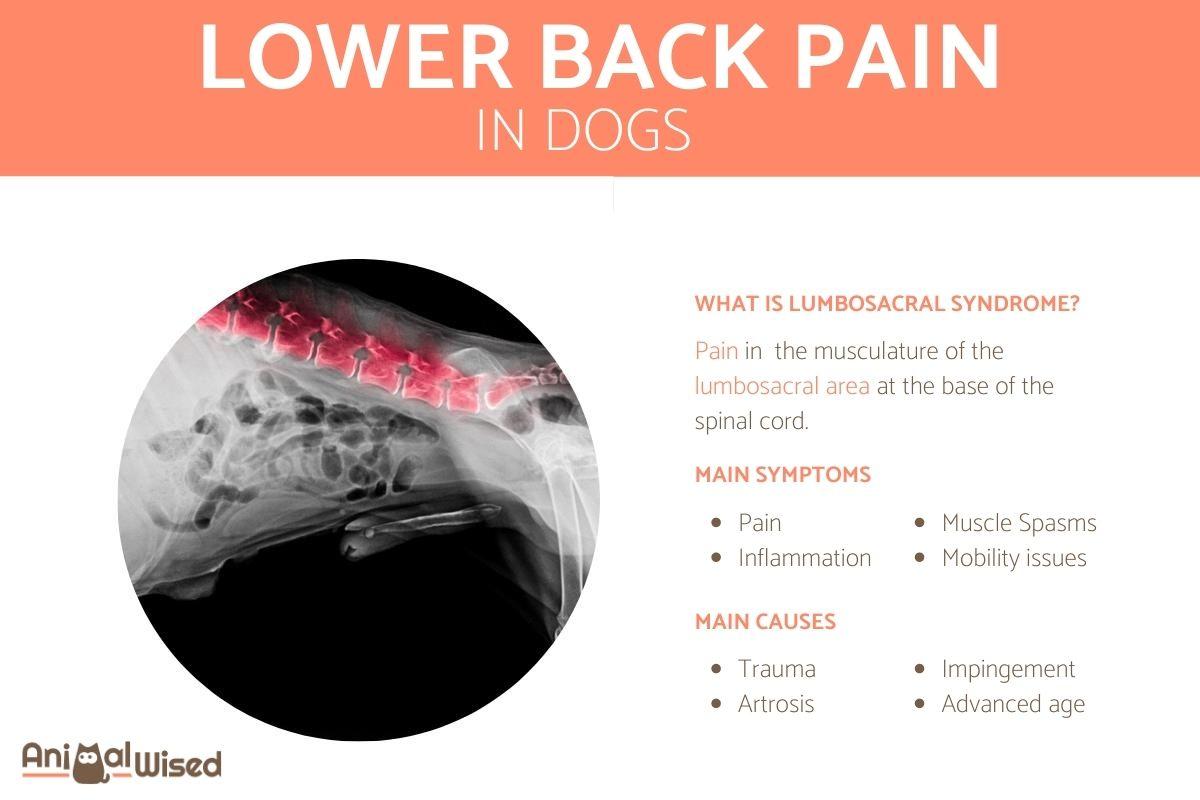My Dog Has Lower Back Pain



See files for Dogs
Lower back pain is a painful condition experienced by dogs in the lumbosacral area. This is the area between the last 3 lumbar vertebrae (L5, L6 and L7) and the sacrum bone (which connects the pelvis with the spine). It may be caused by different conditions or diseases, so accurate diagnosis requires imaging tests, and we must always perform a correct neurological examination and physical examination. Appropriate treatment will depend on the specific cause.
Keep reading this AnimalWised article to learn more about lower back pain in dogs, its causes, symptoms, diagnosis and treatment.
What is lower back pain in dogs?
Lower back pain or lumbosacral syndrome in dogs is defined as pain located in the part furthest down our dog's back, specifically the musculature of the lumbosacral area spine near the tail. Lumbosacral syndrome leads to an increase in tension, tone and stiffness in the muscles in this area of the dog.
This pain is a nervous response mechanism, activating the neural pathways that transmit pain and the development of inflammation and muscle tension. Sometimes the nerve root can be compressed causing impingement, and even protrusion and herniation of the spinal cord and discs.
If you want to know more about herniation in dogs, take a look at our article on canine diaphragmatic hernias.
Causes of lower back pain in dogs
The origin of lower back pain in dogs can be explained by the following medical conditions and diseases:
- Muscular overload
- Traumatism
- Fractures caused by osteoporosis
- Pinching
- Arthrosis
- Advanced age
- Scoliosis
- Inflammatory disorders of the vertebrae, infections or tumors
- Ankylosing spondylitis (AS)
- Lumbar disc herniation
- Lumbosacral stenosis or cauda equina syndrome (CES)
Is there any predisposition for the development of lower back pain in dogs?
Although any dog, independent of breed, sex and age, can develop lower back pain throughout their life, it is true that it is seen more frequently in older dogs. This is due to the natural wear and tear of the bones and joints caused by old age, or if they have developed to arthrosis or osteoporosis. It is seen with the same frequency in males as in females.
It can, however, be seen more frequently in the following dog breeds:
- Dachshund: due to its long back, it is predisposed to suffer herniated discs.
- French Bulldog: predisposed to ankylosing spondylitis (AS).
- Labrador, German Shepherd or other large dog breeds: these are more predisposed to the development of lumbosacral stenosis, also called cauda equina syndrome (CES).
In summary, dogs of chondrodystrophic breeds, i.e. dogs with a long spine and short legs, are more prone to the development of herniated discs. This is due to the stress put on the intervertebral discs by this particular body shape. On the other hand, large dog breeds are more predisposed to the development of osteoarthritis or spondylosis as the years go by.

Symptoms of lower back pain in dogs
If a dog has lumbosacral syndrome, the following symptoms may appear:
- Discomfort
- Pain
- Inflammation
- Muscle contracture
- Tingling
- Alterations in sensitivity
- Reduced mobility and activity
- Numbness
- Increased temperature in the area due to swelling
- Changes in mood
- Depression
- Excess weight
The consistent clinical sign is pain, especially if there has been impingement, protrusion, spondylitis or a herniated disc. This pain can be detected in the initial stages when our dog stops running around, has difficulty climbing stairs, walks more slowly and is generally less active. Later, they will not feel like walking and will rest for longer periods of time. In the most severe cases they will complain with a squeak when we touch the affected area.
Unfortunately, dogs are too good at hiding their pain, at least in early stages. This is why is is vital we are always observant for any signs of pain in dogs.
In addition, in the most severe cases such as disorders affecting the spinal cord or disc herniation, paralysis may be caused when signaling from the nerves is reduced or disappears.
Diagnosis of lower back pain in dogs
Diagnosis of lower back pain should be based on a combination of clinical signs, a neurological examination and diagnostic imaging. This will determine the specific cause of our dog’s back pain.
Clinical signs can pinpoint lesions in the area of the back closest to the rear. Combined with a complete neurological analysis, testing spinal reflexes, sensitivity and responses, these will pinpoint lesions in the medullary segments of the lumbosacral area (L4-S3).
Diagnostic imaging such as radiography will allow us to observe the appearance of the vertebrae in the area. This allows us to observe changes characteristic of ankylosing spondylitis, changes indicative of infection or inflammation, or other causes.
However, to obtain an accurate and definitive diagnosis of our dog’s condition, we should perform advanced imaging techniques such as magnetic resonance imagining or computed tomography. These may not be available in all veterinary clinics, so it may be necessary for your dog to go to a specialist.

Treatment of lower back pain in dogs
The treatment of lower back pain in dogs will depend on the original cause. However, drugs, such as anti-inflammatory analgesics to reduce pain and discomfort are almost always used. In addition, applying heat to the affected area can comfort these dogs. Products such as thoraco-lumbar thermal supports serve this purpose and also protect the affected area.
On the other hand, rehabilitation and physiotherapy are excellent for lower back pain problems. This is especially true after surgical operations, to aid recovery and improve the final results. Surgery, on the other hand, should be limited to the most serious cases where a surgical solution is required. For instance, surgery may be used if traditional therapy is not successful in treating a herniated disc that is compressing the spinal cord.
In addition, excess weight and obesity caused by reduced mobility should be prevented with the appropriate weight loss feed. Give the dog only the feed that is appropriate to its particular condition.

This article is purely informative. AnimalWised does not have the authority to prescribe any veterinary treatment or create a diagnosis. We invite you to take your pet to the veterinarian if they are suffering from any condition or pain.
If you want to read similar articles to My Dog Has Lower Back Pain, we recommend you visit our Other health problems category.







